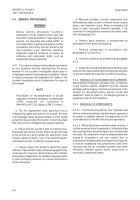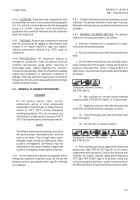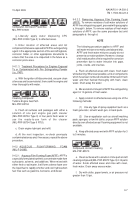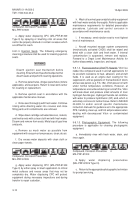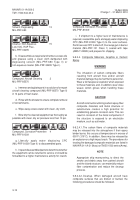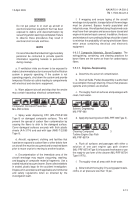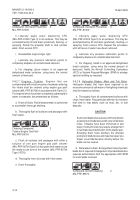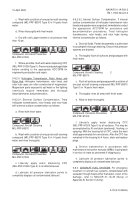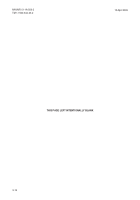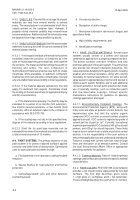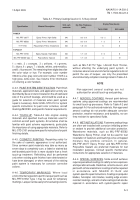TM-1-1500-344-23-2 - Page 167 of 240
9-13
NAVAIR 01-1A-509-2
TM 1-1500-344-23-2
15 April 2009
WARNING
Do not put power to or start up aircraft or
electronic/electrical equipment that has been
exposed to debris until decontamination by
vacuuming and/or washing is completed. Failure
to observe these procedures may result in
electrical short circuits and fires.
NOTE
It is recommended that industrial hygiene/safety
personnel be contacted to provide specific
information regarding hazards to personnel
during cleanup.
a. If ventilation inlets are known to be exposed to
debris, take immediate action to ensure that the filtration
system is properly operating. If the system is not
operating properly, shut down the system and provide
temporary filtration at outlets leading to compartments
with electrical and electronic equipment.
b. Warn adjacent aircraft and ships that the smoke
may contain hazardous electrical contaminants.
Compound, Corrosion Preventive
4
MIL-PRF-81309
c. Spray water displacing CPC (MIL-PRF-81309
Type II) on damaged composite surfaces. This will
prevent the spread of carbon fiber contamination by
causing the fibers to stick to the damaged surface.
Cover damaged surfaces securely with thick plastic
sheets (A-A-3174) and seal with tape (AMS-T-22085
Type II).
d. Aircraft, equipment, clothing and facilities that
have been exposed to carbon fiber or other debris from
an aircraft fire must be vacuumed and/or washed down
prior to reuse or prior to moving to another location.
e. Decontamination of the immediate area of the
aircraft wreckage may require vacuuming, washing,
and bagging of composite material fragments. Use a
sealed industrial vacuum cleaner. Store collected debris
in sealed, plastic bags for the accident investigation.
Dispose of in accordance with applicable environmental
and safety regulations when so directed by the
investigation team.
f. If wrapping and secure taping of the aircraft
wreckage is not possible, transportation of the wreckage
must be planned. Bypass heavily populated and
industrial areas. Aircraft parked along the planned route
must have their canopies and access doors closed and
engine inlet and exhaust covered. In addition, the doors
and windows of surrounding buildings should be closed
to minimize the probability of having wind-blown fibers
enter areas containing electrical and electronic
equipment.
9-8.2.5.Composite Materials, Boron/Tungsten. The
extinguishing, containing, and cleaning practices for
boron fibers are the same as those for carbon/epoxy
fibers.
9-8.2.6. Engines, Reciprocating.
a. Determine the extent of contamination.
b. Drain all fluids. Partial disassembly is authorized
to accomplish thorough draining. Ensure that pressure
systems and cylinders are drained.
c. Thoroughly flush all surfaces and passages with
clean, fresh water.
Solvent, Degreasing
13
MIL-PRF-680
d. Apply dry cleaning solvent (MIL-PRF-680 Type II).
Cleaning Compound
3
Turbine Engine Gas Path
MIL-PRF-85704
e. Flush all surfaces and passages with either a
solution of one part engine gas path cleaner
(MIL-PRF-85704 Type II) in four parts fresh water or use
the ready-to-use form of the cleaner (MIL-PRF-85704
Type II RTU).
f. Thoroughly rinse all areas with fresh water.
g. Allow to drain thoroughly. Dry using paper towels,
cloths, or air pressure less than 10 psi.
Back to Top


